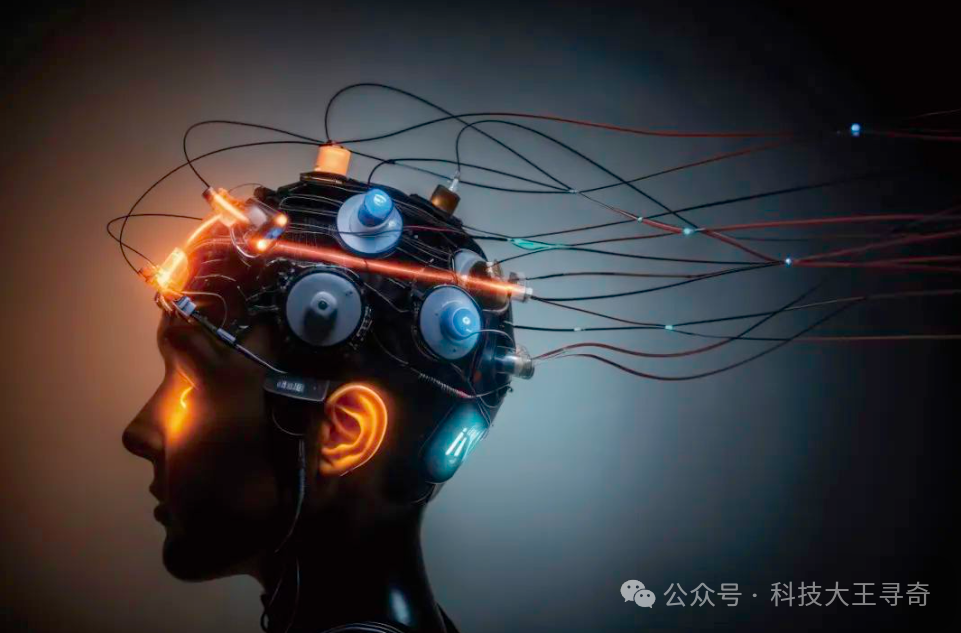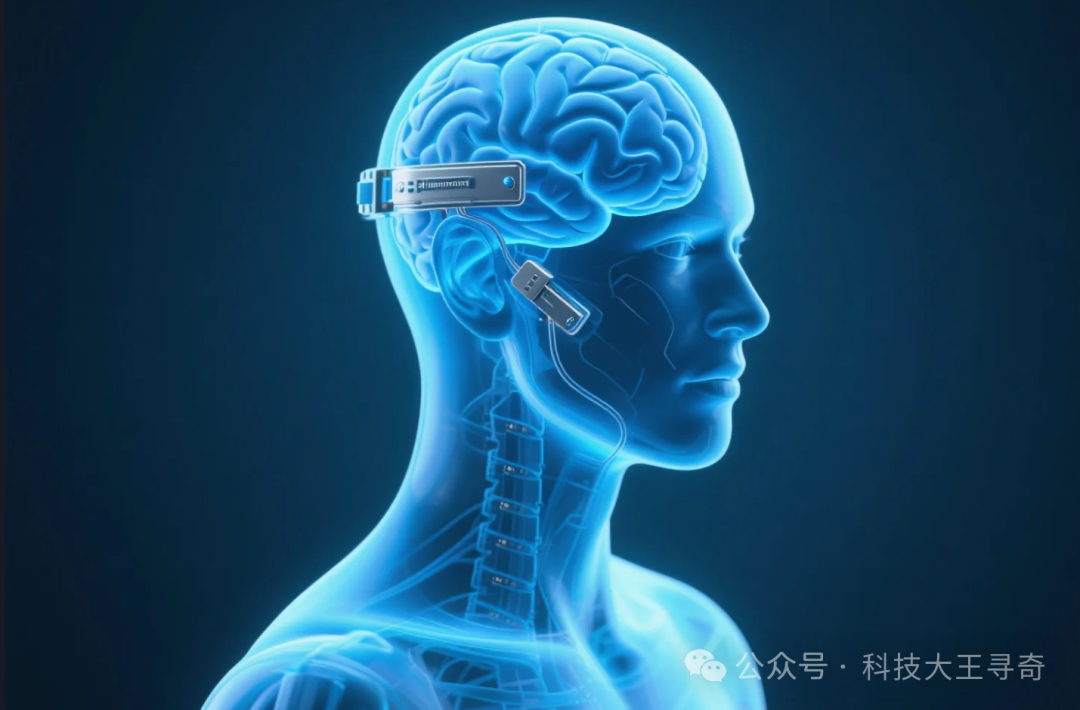
 Chip brain, allowing your child to be born as a sage!Today, at a robotics exhibition, I encountered something quite interesting. It wasn’t particularly rare, just a mechanical hand that could mimic human hand movements based on an external camera. However, there was something intriguing written on the display board behind it—controlling hand movements with thought, making the mechanical hand a part of your body!This reminded me of something I had learned about before—brain-machine interfaces. I nervously inquired with the staff, and indeed, the advanced version of this technology is realized through brain-machine interfaces, although the project is still in the research and development stage, and no samples were available for display.
Chip brain, allowing your child to be born as a sage!Today, at a robotics exhibition, I encountered something quite interesting. It wasn’t particularly rare, just a mechanical hand that could mimic human hand movements based on an external camera. However, there was something intriguing written on the display board behind it—controlling hand movements with thought, making the mechanical hand a part of your body!This reminded me of something I had learned about before—brain-machine interfaces. I nervously inquired with the staff, and indeed, the advanced version of this technology is realized through brain-machine interfaces, although the project is still in the research and development stage, and no samples were available for display. Brain-machine interface:However, that was just a small exhibition. After an overnight search for information, I found that this technology is already in deep research and seems to have made significant achievements.Currently, there are three types of connections for brain-machine interfaces—non-invasive, semi-invasive, and invasive.Non-invasive methods are generally being developed by some small and medium-sized companies both domestically and internationally. The main approach is through a headset equipped with many suction cup-like devices, which transmit brain waves between these cups, converting biological signals into electronic signals that computers can understand.Of course, all types of brain-machine interfaces obtain brain information in this way, but the difficulty of obtaining brain information varies depending on the insertion location, which also affects the difficulty of implanting the brain-machine interface.The relatively simple non-invasive method is also the most common and carries the lowest risk, mostly researched by private enterprises; while the state focuses more on semi-invasive brain-machine interface research, which has lower risks while also aiming to enhance the speed and clarity of electrical signal transmission; as for invasive research, currently, there is only one institution in the world studying it, and the founder of this research institution is none other than Elon Musk, the founder of Tesla.This does not imply that Musk is particularly impressive; rather, it is indeed a very challenging field that requires high costs, time, and humanitarian considerations.
Brain-machine interface:However, that was just a small exhibition. After an overnight search for information, I found that this technology is already in deep research and seems to have made significant achievements.Currently, there are three types of connections for brain-machine interfaces—non-invasive, semi-invasive, and invasive.Non-invasive methods are generally being developed by some small and medium-sized companies both domestically and internationally. The main approach is through a headset equipped with many suction cup-like devices, which transmit brain waves between these cups, converting biological signals into electronic signals that computers can understand.Of course, all types of brain-machine interfaces obtain brain information in this way, but the difficulty of obtaining brain information varies depending on the insertion location, which also affects the difficulty of implanting the brain-machine interface.The relatively simple non-invasive method is also the most common and carries the lowest risk, mostly researched by private enterprises; while the state focuses more on semi-invasive brain-machine interface research, which has lower risks while also aiming to enhance the speed and clarity of electrical signal transmission; as for invasive research, currently, there is only one institution in the world studying it, and the founder of this research institution is none other than Elon Musk, the founder of Tesla.This does not imply that Musk is particularly impressive; rather, it is indeed a very challenging field that requires high costs, time, and humanitarian considerations. Non-invasive brain-machine interface:A non-invasive brain-machine interface (BCI) is a technology that allows direct interaction between the human brain and external devices without surgical implantation, by collecting brain electrical signals through the scalp. Its core lies in converting neural electrical signals into machine-recognizable commands, offering significant advantages in safety and usability. Currently, China has achieved a global leading position in this field, with technological breakthroughs and commercialization accelerating simultaneously. By 2025, the global non-invasive BCI market is expected to exceed $12 billion, with China’s market share reaching 32%, growing faster than the global average. The policy side has also listed it as one of the “ten iconic future industries,” with cities like Beijing and Shanghai clearly stating their goals to achieve independent control of core technologies and clinical applications by 2030.In terms of technology, China has pioneered the “dual-loop” brain-machine interaction system, breaking through traditional control time limitations, and has dominated 41% of global non-invasive (BCI) patents.
Non-invasive brain-machine interface:A non-invasive brain-machine interface (BCI) is a technology that allows direct interaction between the human brain and external devices without surgical implantation, by collecting brain electrical signals through the scalp. Its core lies in converting neural electrical signals into machine-recognizable commands, offering significant advantages in safety and usability. Currently, China has achieved a global leading position in this field, with technological breakthroughs and commercialization accelerating simultaneously. By 2025, the global non-invasive BCI market is expected to exceed $12 billion, with China’s market share reaching 32%, growing faster than the global average. The policy side has also listed it as one of the “ten iconic future industries,” with cities like Beijing and Shanghai clearly stating their goals to achieve independent control of core technologies and clinical applications by 2030.In terms of technology, China has pioneered the “dual-loop” brain-machine interaction system, breaking through traditional control time limitations, and has dominated 41% of global non-invasive (BCI) patents. Among them, flexible electrode materials and dry sensor technology have significantly improved wearing comfort by 300% (in simple terms, these are more suitable electrode materials), and new machine learning architectures have reduced the signal decoding error rate to below 5%, with real-time feedback latency controlled within 50 milliseconds.In terms of application scenarios, the medical rehabilitation and education fields have become dual engines: BrainCo’s intelligent bionic prosthetics have achieved the world’s first mass production of 100,000 units, assisting disabled individuals in restoring motor functions, with quarterly sales of their bionic hand prosthetics reaching 4-5 times that of the entire year of 2023; the consumer market is also booming, with products for attention training and sleep disorder interventions (such as brain-machine intelligent sleep devices) accelerating in popularity, and by 2025, the user base for educational BCIs is expected to exceed 8 million..
Among them, flexible electrode materials and dry sensor technology have significantly improved wearing comfort by 300% (in simple terms, these are more suitable electrode materials), and new machine learning architectures have reduced the signal decoding error rate to below 5%, with real-time feedback latency controlled within 50 milliseconds.In terms of application scenarios, the medical rehabilitation and education fields have become dual engines: BrainCo’s intelligent bionic prosthetics have achieved the world’s first mass production of 100,000 units, assisting disabled individuals in restoring motor functions, with quarterly sales of their bionic hand prosthetics reaching 4-5 times that of the entire year of 2023; the consumer market is also booming, with products for attention training and sleep disorder interventions (such as brain-machine intelligent sleep devices) accelerating in popularity, and by 2025, the user base for educational BCIs is expected to exceed 8 million.. Semi-invasive brain-machine interface:
Semi-invasive brain-machine interface:
A semi-invasive brain-machine interface involves minimally invasive surgery to implant flexible electrodes between the skull and the outer dura mater of the brain, avoiding the risk of direct contact with brain tissue that invasive techniques pose, while significantly improving signal quality (with less attenuation compared to non-invasive scalp collection). This has become the most industrially viable technical route in China’s brain-machine interface field.Domestically, significant breakthroughs have been achieved in this area: at the beginning of 2025, “Beijing Brain No. 1,” as the world’s first flexible high-throughput semi-invasive wireless fully implanted system, led by the Beijing Institute of Brain Science and Brain-like Research, completed the first batch of human implants, with its 128-channel synchronous collection capability ranking first in the world. The effective channel rate for patients post-surgery exceeds 98%, successfully helping paralyzed patients control robotic arms and computers remotely, and for the first time achieving real-time decoding of Chinese language for aphasic patients (with a single character delay of <100 milliseconds), pushing the reconstruction of motor and language functions into the clinical application stage.The Tsinghua University team, in collaboration with Xuanwu Hospital, completed the world’s first wireless minimally invasive semi-invasive clinical trial in 2023, enabling a patient paralyzed for 14 years to achieve a grip accuracy rate of over 90% three months post-surgery, and the patient was able to be discharged within ten days, significantly lowering the clinical promotion threshold.
 On the policy level, Shanghai and Beijing have successively released action plans, clearly prioritizing semi-invasive development: Shanghai aims to achieve its first batch of clinical applications by 2027, promoting more than five products to complete medical device inspections; Beijing plans to build a global brain-machine interface innovation hub by 2030, strengthening the localization of core components such as electrodes and chips.Industrial transformation relies on deep collaboration between “industry, academia, research, and medicine,” such as “Beijing Brain No. 1” being integrated by Chip Intelligence Company with clinical resources from Peking University Hospital, Xuanwu Hospital, etc., achieving rapid transition from laboratory to operating room.The ethical framework is also being improved simultaneously, with the first “Ethical Guidelines for Brain-Machine Interface Research” in China emphasizing the “repair priority” principle, delineating boundaries for the compliant application of semi-invasive technology.Current challenges focus on long-term biocompatibility optimization and multi-scenario decoding algorithm adaptation, but with the iteration of flexible electrode materials and closed-loop feedback technology, semi-invasive methods are accelerating their expansion from paralysis treatment to broader neurological disease fields such as epilepsy control and depression intervention..
On the policy level, Shanghai and Beijing have successively released action plans, clearly prioritizing semi-invasive development: Shanghai aims to achieve its first batch of clinical applications by 2027, promoting more than five products to complete medical device inspections; Beijing plans to build a global brain-machine interface innovation hub by 2030, strengthening the localization of core components such as electrodes and chips.Industrial transformation relies on deep collaboration between “industry, academia, research, and medicine,” such as “Beijing Brain No. 1” being integrated by Chip Intelligence Company with clinical resources from Peking University Hospital, Xuanwu Hospital, etc., achieving rapid transition from laboratory to operating room.The ethical framework is also being improved simultaneously, with the first “Ethical Guidelines for Brain-Machine Interface Research” in China emphasizing the “repair priority” principle, delineating boundaries for the compliant application of semi-invasive technology.Current challenges focus on long-term biocompatibility optimization and multi-scenario decoding algorithm adaptation, but with the iteration of flexible electrode materials and closed-loop feedback technology, semi-invasive methods are accelerating their expansion from paralysis treatment to broader neurological disease fields such as epilepsy control and depression intervention..
 Invasive brain-machine interface:An invasive brain-machine interface is a technology that involves directly implanting electrodes into the brain to accurately record neural signals. Due to its ability to achieve high-precision data transmission, it has become one of the most groundbreaking fields in current brain-machine interface research. Compared to non-invasive and semi-invasive methods, invasive solutions can penetrate brain tissue directly, capturing more delicate and richer neural activity information, thereby greatly enhancing the clarity and transmission speed of brain electrical signals, making it possible to control mechanical devices, achieve more precise neural signal decoding, and enable deep interaction with the brain. The development of this technology faces extremely high technical difficulties, requiring not only overcoming the risks of implantation surgery but also ensuring the biocompatibility and long-term stability of the implanted devices.
Invasive brain-machine interface:An invasive brain-machine interface is a technology that involves directly implanting electrodes into the brain to accurately record neural signals. Due to its ability to achieve high-precision data transmission, it has become one of the most groundbreaking fields in current brain-machine interface research. Compared to non-invasive and semi-invasive methods, invasive solutions can penetrate brain tissue directly, capturing more delicate and richer neural activity information, thereby greatly enhancing the clarity and transmission speed of brain electrical signals, making it possible to control mechanical devices, achieve more precise neural signal decoding, and enable deep interaction with the brain. The development of this technology faces extremely high technical difficulties, requiring not only overcoming the risks of implantation surgery but also ensuring the biocompatibility and long-term stability of the implanted devices. The achievements of Elon Musk and his team in this field showcase exciting breakthroughs. Their company, Neuralink, is dedicated to overcoming the technical bottlenecks of traditional brain-machine interfaces through innovative microelectrode arrays and advanced surgical techniques, continuously optimizing the performance of implanted devices. Since its establishment, Neuralink has made numerous key breakthroughs in neural signal decoding, non-invasive chip implantation, and high-speed connections between the human brain and computers, successfully testing implantable devices that can work stably for long periods with high signal quality, and demonstrating significant control capabilities of monkeys operating computers and robotic arms.Of course, relying solely on this to achieve success in the more complex human brain structure requires a longer accumulation of experience and technological breakthroughs. However, I believe that invasive brain-machine interfaces will ultimately be the direction of development.After all, needing to display a peculiar chip or a more unusual hat on one’s head is certainly more difficult for the general public to accept, while a situation completely free from external carriers not only maintains aesthetic appeal but also allows for the reception of external information and upgrades at any time.Of course, this is all under the premise that safety can be guaranteed.Nowadays, terms like brain-machine interfaces occasionally enter my daily conversations. With the continuous breakthroughs in global technology and the public’s desire for a better life, perhaps brain-machine interfaces will become a widely recognized technical term in the future.However, I hope that as human technology aids the public, it contributes to a better life, and that we do not lose our essence as humans due to the convenience of life, allowing everyone to live healthily and happily under the future blue sky!
The achievements of Elon Musk and his team in this field showcase exciting breakthroughs. Their company, Neuralink, is dedicated to overcoming the technical bottlenecks of traditional brain-machine interfaces through innovative microelectrode arrays and advanced surgical techniques, continuously optimizing the performance of implanted devices. Since its establishment, Neuralink has made numerous key breakthroughs in neural signal decoding, non-invasive chip implantation, and high-speed connections between the human brain and computers, successfully testing implantable devices that can work stably for long periods with high signal quality, and demonstrating significant control capabilities of monkeys operating computers and robotic arms.Of course, relying solely on this to achieve success in the more complex human brain structure requires a longer accumulation of experience and technological breakthroughs. However, I believe that invasive brain-machine interfaces will ultimately be the direction of development.After all, needing to display a peculiar chip or a more unusual hat on one’s head is certainly more difficult for the general public to accept, while a situation completely free from external carriers not only maintains aesthetic appeal but also allows for the reception of external information and upgrades at any time.Of course, this is all under the premise that safety can be guaranteed.Nowadays, terms like brain-machine interfaces occasionally enter my daily conversations. With the continuous breakthroughs in global technology and the public’s desire for a better life, perhaps brain-machine interfaces will become a widely recognized technical term in the future.However, I hope that as human technology aids the public, it contributes to a better life, and that we do not lose our essence as humans due to the convenience of life, allowing everyone to live healthily and happily under the future blue sky!